“The Westinghouse Desilu Playhouse” ~ November 17, 1958
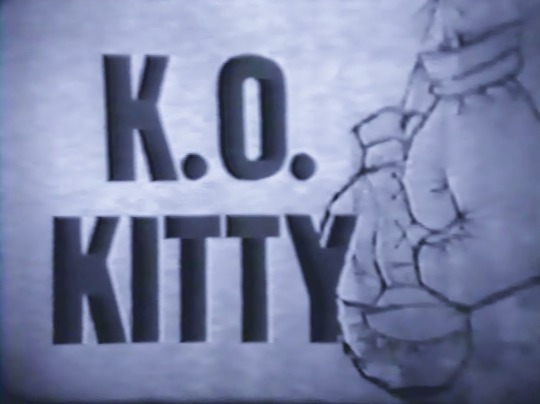
Produced
by Bert Granet, Quinn Martin
Directed
by Jerry Thorpe
Dances
and Fights staged by Jack Baker
Written
by Bob Carroll, Madelyn Davis, Quinn Martin (story)
Synopsis:
Los
Angeles dance
teacher Kitty (Lucille Ball) is delighted when she learns
that she has inherited a boxer from her late Uncle Charlie. But the
boxer turns out not to be a canine, but a prize fighter named Harold
Tibbetts (Aldo Ray), a muscle-bound country boy.
Cast
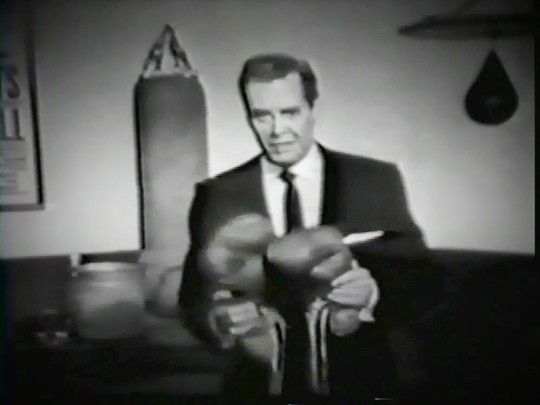
Desi
Arnaz
(Himself, Host) was
born in Cuba in 1917 and immigrated to America as a youngster. He was
a musician who married Lucille Ball in 1940 after meeting her on the
set of 1939’s Too
Many Girls,
which he had done on stage in New York. In order to keep him ‘off
the road’ Ball convinced producers to cast him as her husband in a
new television project based on her radio show “My Favorite
Husband.” The network was convinced. In 1951, Arnaz and Ball began
playing Lucy and Ricky Ricardo, roles they would be identified with
for the rest of their lives. The couple had two children together,
Lucie and Desi Jr. In 1960, Ball and Arnaz divorced. Desi became a
producer, responsible for such hits as “The Mothers-in-Law”
(1967-69). He re-married in 1963. Desi Aranz died in 1986, just a few
years before Ball.
Lucille
Ball (Kitty
Winslow) was
born on August 6, 1911 in Jamestown, New York. She began her screen
career in 1933 and was known in Hollywood as ‘Queen of the B’s’
due to her many appearances in ‘B’ movies. With Richard Denning,
she starred in a radio program titled “My Favorite Husband” which
eventually led to the creation of “I Love Lucy,” a television
situation comedy in which she co-starred with her real-life husband,
Latin bandleader Desi Arnaz. The program was phenomenally successful,
allowing the couple to purchase what was once RKO Studios, re-naming
it Desilu. When the show ended in 1960 (in an hour-long format known
as “The Lucy-Desi Comedy Hour”) so did Lucy and Desi’s
marriage. In 1962, hoping to keep Desilu financially solvent, Lucy
returned to the sitcom format with “The Lucy Show,” which lasted
six seasons. She followed that with a similar sitcom “Here’s
Lucy” co-starring with her real-life children, Lucie and Desi Jr.,
as well as Gale Gordon, who had joined the cast of “The Lucy Show”
during season two. Before her death in April 1989, Lucy made one more
attempt at a sitcom with “Life With Lucy,” also with Gordon,
which was not a success and was canceled after just 13 episodes.
Most
sources list Kitty’s surname as ‘Williams.’ Her last name is clearly
spoken twice in the teleplay as ‘Winslow.’
Aldo
Ray
(Harold Tibbetts, below center) was born as Aldo DeRe and nicknamed ‘the Rugged
Romeo’. In 1964 he worked again with Lucille Ball in Bob Hope’s “Have
Girls, Will Travel” (1964). His career waned in the 1970s. He
died in 1991.
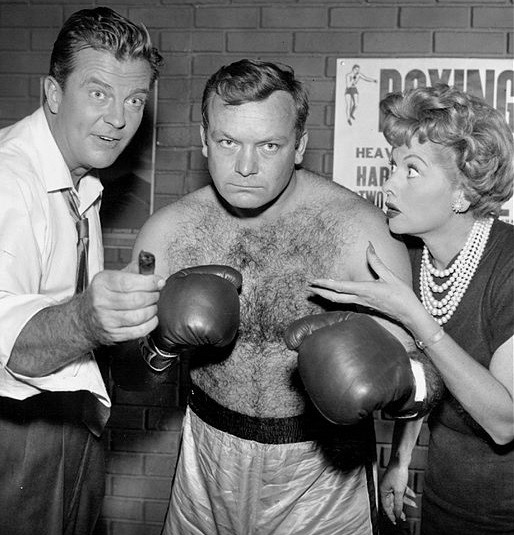
William
Lundigan (David
Pierce, above left) was a genial ‘B’ movie and TV actor. His career began in
1937. His last television role was in 1971. He was a good friend of
William Frawley (Fred Mertz) and served as pallbearer at his funeral. Lundigan
died in 1975.
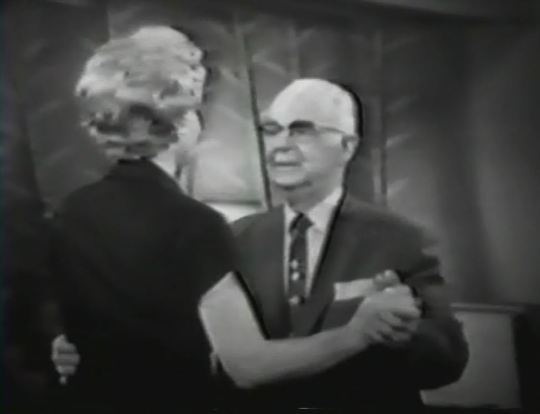
Harry
Cheshire (Mr.
Brubaker) did three films with Lucille Ball between 1947 and 1950. He
played Sam Johnson, a Texan who sells Lucy and Ricky “Oil Wells”
(ILL S3;E18) in 1954. His
best-known role was as Judge Ben Wiley in the TV series
“Buffalo Bill, Jr.” (1955). He died in 1968 at the age of 76.
Jesse
White (Barney
Snyder, below right) is
probably best remembered for playing the lonely Maytag repairman on
TV commercials airing from 1967 to 1988. A busy character actor,
White subsequently starred opposite Lucille Ball on a 1972 episode of
“Here’s Lucy.” He died in 1997.
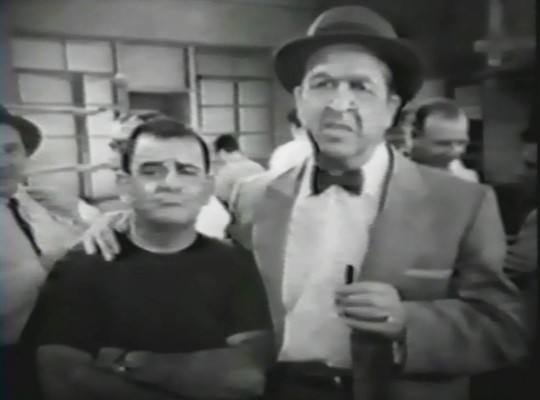
Sid
Melton
(Louie, above left) also appeared
on the “Westinghouse Desilu Playhouse” as a bellboy in “Lucy
Goes to Alaska”
(February
1959) and as a construction worker in “Milton Berle Hides Out at
the Ricardos” (September 1959). He played one of the jockeys in
“Lucy
Wins a Racehorse”
(February
1958). He later played Charley Halper on “Make Room For Daddy” (filmed at Desilu) and Alf Monroe on "Green Acres” (aired on CBS).
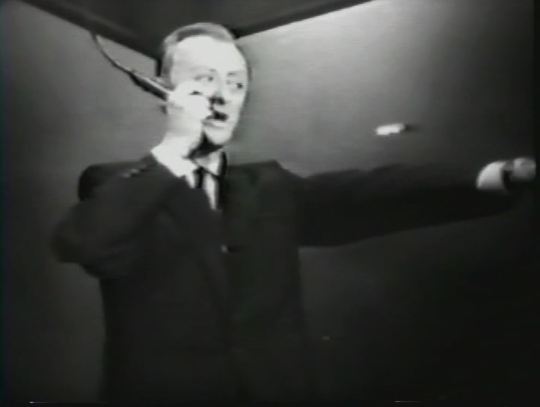
Frankie
Van
(Himself, Referee) was a stand-in and background performer whose
more than 50 credits are nearly all as referees in films and
television shows about boxing. Fittingly, his last screen credit was
as a referee in Rocky
(1976).
In
this script, Van is called by his real name.
Freddie
Beshore
(Tommy Thompson, uncredited) picked up boxing while serving in the
United States Navy during World War II. During his career he was the
Heavyweight Champion of the Pacific Coast. During the late 1940s and
early 1950s he was a top heavyweight title contender.
Norman
Leavitt
(Policeman, uncredited) appeared
with Lucille Ball in the 1950 film A
Woman of Distinction as
well as The
Long, Long Trailer (1953).
The character actor also appeared on three episodes of “The
Lucy-Desi Comedy Hour” and
two episodes of “The Lucy Show.”
About
“The Westinghouse Desilu Playhouse”

After
the end of the half-hour “I Love Lucy” episodes, Desi Arnaz
convinced CBS to purchase an anthology series titled “Desilu
Playhouse” which would feature different hour-long dramas every
week along with monthly stories of the Ricardos and the Mertzes,
something begun a year before.

Thirteen hour-long “I Love Lucy”
adventures were eventually made and sold to syndication as “The
Lucy-Desi Comedy Hour,” ten of which were produced under the
Westinghouse sponsorship. The appliance company paid a then-record 12
million dollars to sponsor the show.

Desi Arnaz hosted the show and
introduced the stories. Desi, Lucy, Vivian Vance, and William
Frawley, were often involved in the lengthy studio-filmed
commercials, with Betty Furness spokesperson for the Westinghouse
products. Although it wasn’t around long, the show gave birth to
pilots for “The Untouchables” and “The Twilight Zone.”

In
the summer of 1958, in anticipation of their partnership, the cast of
“I Love Lucy” played themselves in an industrial film (known as “Lucy Buys
Westinghouse”) that toured the Desilu Studios, promoted “Lucy
Goes to Mexico”, and highlighted Westinghouse appliances. The film
was never in theatrical release or broadcast, but only shown Westinghouse dealers and
corporate clients.

The
Desilu Playhouse was also an actual little theatre on the Desilu
backlot which hosted classes for actors and put on workshop shows for
agents and industry insiders. When Lucille Ball joined RKO in the
1930s, the program was headed by Ginger Rogers’ mother, Lela. Lucy
wanted to continue the tradition. It was depicted in both “The
Desilu Revue” (December 25, 1959) and “Hedda Hopper’s Hollywood”
(January 10, 1960).
About
“K.O. Kitty”

In
the title, “K.O” is boxing term short for “Knock Out,” when a
fighter has hit his opponent so hard that he hits the mat and cannot
get up again.

This
is the first time that Lucille Ball acted on television not playing
Lucy Ricardo. Lucille
Ball was supposed to do several more non-Lucy Ricardo roles on the
series, but this was the only one that ever materialized.
The series ended in 1960, along with the Arnaz marriage. “The
Desilu Playhouse” went
into syndication, minus the Lucy-Desi Comedy Hours. In 1962, Desilu
sold those 13 shows back to CBS for $750,000.

Quinn
Martin (Producer / Story) was married to “Lucy” writer Madelyn
Pugh Davis from 1955 to 1960. His production company was later
responsible for such hits as “The Streets of San Francisco”
(1972-77), “The Fugitive” (1963-67), and “Barnaby Jones”
(1973-78) earning him four Emmy nominations. He also produced nine
other episodes of “The Westinghouse Desilu Playhouse.”

Like
“I Love Lucy” and “The Lucy-Desi Comedy Hour,” the episode
uses a laugh track. Unlike most of those shows, there was no studio
audience. “K.O. Kitty” followed “Lucy Goes to Mexico” (October) and was followed by “Lucy Makes Room for Danny” (December), a cross-over episode with “Make Room for Daddy.”

Earlier
in 1958, boxing made the cover of Life Magazine when Sugar Ray
Leonard beat Carmen Basilio.

Boxing had been a major attraction on television, the highlight being the “Playhouse 90” presentation of “Requiem for a Heavyweight” in 1956 on CBS. It was directed by Rod Serling (”The Twilight Zone”) and starred Jack Palance.

A
country boy out of his element, Harold Tibbetts (Aldo Ray) is
reminiscent of when Tennessee Ernie Ford visited the Ricardos on “I
Love Lucy.” Like Cousin Ernie, Harold has an enormous appetite and
can’t return home because he has no money. He also tends to speak
with homespun wit.

Harold
also resembles another visitor to the Ricardo apartment, Mario (Jay Novello), the
“Visitor From Italy” (ILL S6;E5). Like Harold, Mario had no cash
to and had to go to work – in his case making pizza.

But
“K.O. Kitty” most closely resembles a 1967 episode of “The Lucy
Show” titled “Lucy, the Fight Manager” (TLS S5;E20) starring
Don Rickles as a washed-up boxer named Eddie who Lucy Carmichael
decides to train at home. Lucy dubs herself ‘Killer Carmichael’ and
even jumps rope in tandem with Eddie, a stunt she learned to do for
“K.O. Kitty.” Despite being by different writers, both scripts
contain characters named Louie.
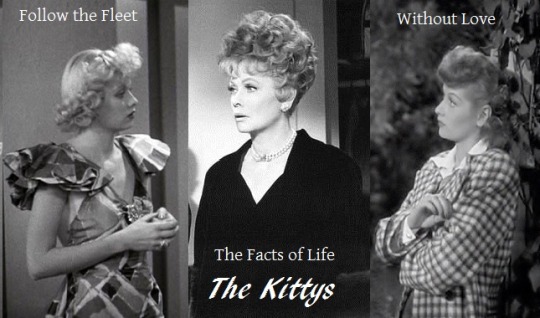
Lucille Ball also played characters named Kitty
in the films Follow
the Fleet (1936),
Without
Love
(1945), and The
Facts of Life
(1960). A name featuring two-syllables ending with ‘y’ made reminded
the listener of ‘Lucy’.

Eight
months later “The Westinghouse Desilu Playhouse” did another
story about prizefighting titled “The Killer Instinct” starring
Rory Calhoun and Janice Rule. It was based
on the career of ex-boxer Joe Barnum.
The Episode
Desi
Arnaz introduces the program, noting that it is a special episode
because it stars “his favorite redhead” Lucille Ball.

The
story opens with Kitty at work, teaching dance. She is trying to get
Mr. Brubaker (Harry Cheshire) to do the Cha-Cha.
Kitty:
“Your
feet are doing the cha-cha-cha but your hips are back in the rumba
class.”
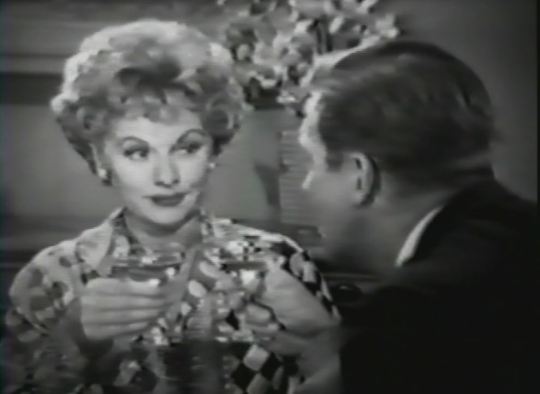
During
the dance lesson, we learn that Kitty is engaged to an up-and-coming
lawyer named David (William Lundigan) who won’t marry her until he gets a partnership in his
law firm, Abbott Parker and Jones. She tells Mr. Brubaker that he is
dancing with an ‘heiress’ due to her Uncle Charlie dying and leaving
her a diamond stick-pin, a gold pocket watch, and a dog – a boxer,
to be precise.
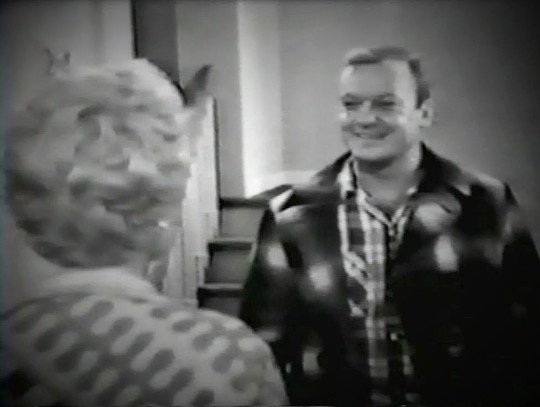
David
(William Lundigan) tells Kitty he is going away on a business trip to
San Francisco for a week. During their romantic dinner, there is a
knock on the door and the boxer arrives – Harold Tibbetts,
professional prize fighter. Tibbetts admits he’s not really from
Ogalala, Nebraska, but from Crockett – just “a hoot and holler”
away.
Harold:
“I’m
so hungry, my stomach’s a-growlin’ like hound dog’s just smelled a
weasel in a hen house.”
Overcome
with a sense of loyalty to her Uncle Charlie, Kitty agrees to manage
Harold. She arranges for Harold to fight the impressive Tommy
Thompson, a powerhouse that no one wants to go up against. Kitty cannot
afford the gym fees so trains him at her apartment.
The name Tommy Thompson was also the name of a producer who worked extensively with Lucille Ball starting in 1964. In 1958 he was on the Desilu lot working as assistant director on “The Danny Thomas Show”
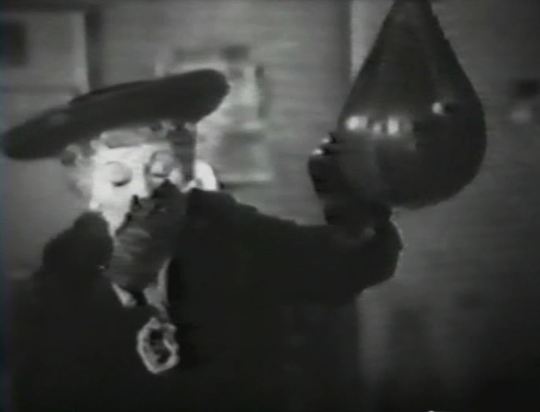
Kitty
sends Harold off to the store to buy training supplies while she
stays behind at the gym to observe and pick up some pointers on
boxing. First, she indulges in a little shadow boxing. Next she
tries to use a punching bag, but it punches back – right in her
face. Remembering how to jump rope from her childhood, she jumps into
a boxer’s reps keeping time with a schoolyard rhyme. These are all
prime opportunities for Lucille Ball to indulge in some of her
well-hone physical comedy skills.
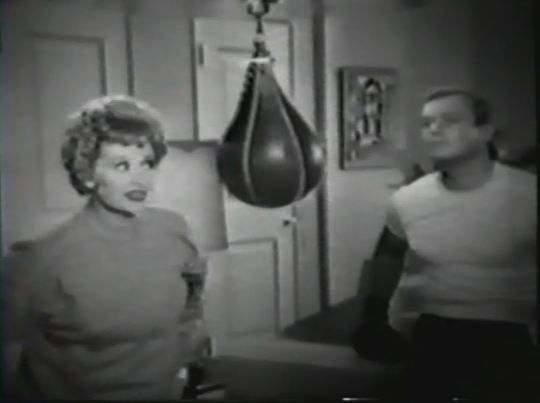
Back
at the apartment, there is a montage of scenes of Kitty training
Harold. He knocks the punching bag out the window, shatters a mirror
while shadow boxing, and crashes to the floor while jumping rope.
Kitty decides that the best training for klutzy Harold would be
dancing lessons.

They
begin lessons by dancing to “I
Can’t Give You Anything But Love, Baby”
by
Jimmy
McHugh
and Dorothy
Fields.
The song was introduced on Broadway in Blackbirds
of 1928.

The dance lesson scene is nearly identical to when Lucy Ricardo
taught awkward Arthur Morton (Richard Crenna) to dance in “The
Young Fans” (ILL S1;E20) in 1952.
David returns unexpectedly from
San Francisco to find Kitty and Harold in a carefree clinch. Kitty attempts to explain what is going on but it devolves into an argument and
David storms out.

Using
Kitty’s dance steps and her singing “I Can’t Give You Anything But
Love” from ringside as inspiration, Harold surprisingly wins his bout against Tommy Thompson.

He
then wins a second fight.

And
a third!
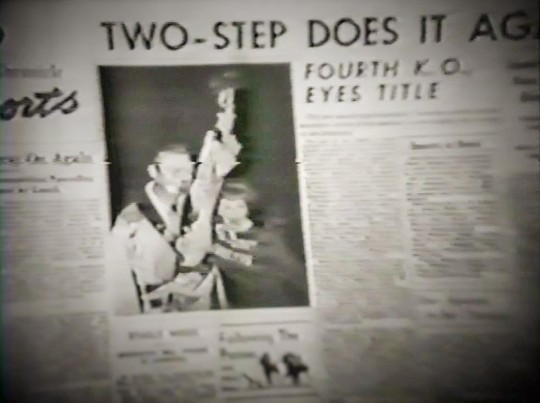
With a fourth K.O. under his belt thanks to Kitty, he eyes the title!
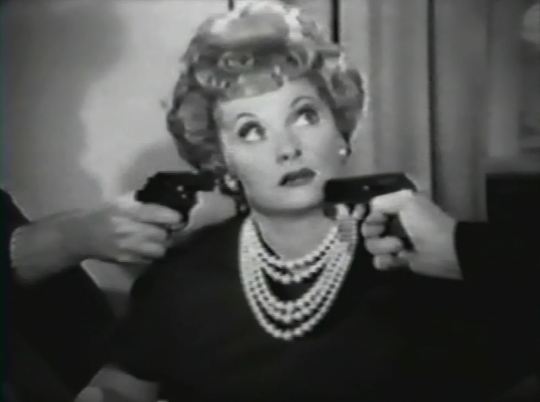
Barney Snyder (Jesse White) and
David conspire to get Kitty out of the fight game – for both their
sake. Snyder and Louie (Sid Melton) show up at Kitty’s apartment,
guns drawn, to convince Lucy that they are crooks, and that the fight
is fixed.
Meanwhile,
back at the gym, ‘Two Step Tibbetts’ (as he’s now called) is waiting
for Kitty to arrive knowing he can’t win the fight without her
singing ringside while he spars. David arrives to tell Harold the bad
news that Kitty will be detained. He learns from Harold that earlier
that day they decided that this would be his last fight. David offers
to sing instead of Kitty, but Harold can’t remember the name of the
song – except that the word ‘love’ was in the title.

Still at gunpoint, Kitty watches the match from home on TV. When Barney and Louis become engrossed in the fight, Kitty hides in the closet. This
is very reminiscent of “Ricky and Fred are TV Fans” (ILL S2;E30)
where Lucy and Ethel manage to evade the police when they can’t take
their eyes off a televised boxing match.
Meanwhile, back at the ring,
Harold is taking a beating while David rattles off the title of every
‘love’ song he can think of, including a few bars of “I Love You
Truly,” a traditional wedding song.
Barney
and Louis confess to Kitty that they made up their story about being mobsters.
Their guns are actually cigarette lighters! They spill the beans to
Kitty about their plans. In order to get to the stadium as fast as
possible, Kitty pretends she’s going to have a baby and gets a police
escort. Kitty and David rush to the ringside in time to sing the
song, which everyone in the stadium joins in. At the final moment,
Harold lands a knock out punch and wins the fight. David and Kitty
make-up with a kiss as the program ends.
Ringside
With Lucy

Lucy
Ricardo and Ethel Mertz ended up at the fights in the last scene of
1951’s “The
Girls Want to Go to a Nightclub” (ILL S1;E1),
the very first “I Love Lucy” episode ever aired.

Everyone
but Lucy and Ethel seem to be watching the fights on television in
“Ricky
and Fred are TV Fans” (ILL S2;E30).

This
Date in Lucy History
~ November 17

"Lucy
and the Used Car Dealer”
(HL S2;E9) ~ November 17, 1969
Leave a comment